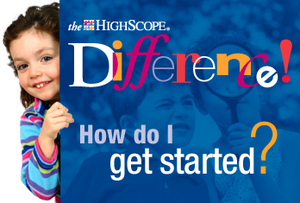We use creative, high quality, developmentally appropriate High-Scope curriculum and teacher resources.The curriculum provides a balance of daily teacher-directed activities and child-directed activities. Our teacher’s goal is to make learning fun and help prepare your child for the future. Our curriculum provides a variety of activities that are designed to engage and develop parts of the brain throughout the following learning scope.We use all the quality products from High-Scope.
HighScope for Parents
As parents, we all want to do everything we can to help our children be successful in school and in life. But it can be difficult to know exactly how to help them because we hear so much conflicting information about how children learn. Think about your own school experiences from childhood. You may remember your favorite teachers or subjects, which lessons were easy or difficult, and so forth. But, did you ever ask yourself why that teacher was your favorite, or why you liked that subject so much? Did you ever wonder whether you could have done better in school had you been taught a different way?
Curriculum Overview
Adults and Children — Partners in Learning In High-Scope’s vision of preschool education, children are doers and problem solvers, and adults are partners who share in children’s discoveries and gently guide their learning.

The High-Scope early childhood education approach, used in preschool, kindergarten, childcare, or elementary school settings, was developed in Ypsilanti, Michigan in the 1960s. It is now common there and in some other countries.
The philosophy behind High-Scope is based on child development theory and research, originally drawing on the work of Jean Piaget and John Dewey. Since then, the HighScope Curriculum has evolved to include the findings of ongoing cognitive-developmental and brain research. In its teaching practices, the High-Scope Curriculum draws upon the work of developmental psychologist and educator Lev Vygotsky, especially the strategy of adult scaffolding — supporting children at their current developmental level and helping them build upon it — in a social setting where children have opportunities to choose materials, ideas, and people to interact within the projects they initiate. The adults working with the children see themselves more as facilitators or partners than as managers or supervisors.
Active Learning We call this approach active participatory learning. In it, young children build or “construct” their knowledge of the world — finding out how the world works through their own direct experience with people, objects, events, and ideas.
Curriculum Content The High-Scope Preschool Curriculum is built around 58 developmental milestones called key developmental indicators (KDIs) in 8 curriculum content areas that are closely aligned with state and professional standards. The KIDs define what we teach; the hows are provided by our teaching practices for the classroom learning environment, daily routine, and adult-child interaction.
The Classroom and Daily Routine Teachers set the stage for learning through a carefully planned physical environment and consistent daily routine. Within this structure, children are secure and self-reliant learners.
The centerpiece of the day is High-Scope’s unique plan-do-review process, in which each child has a daily opportunity to make and carry out a plan and then reflect on what happened. This process strengthens the child’s executive function — their ability to regulate and organize themselves so they can stay focused on what they have chosen to do and solve problems that arise.
Relationships: Central to Learning Adult-child interaction is emphasized in the HighScope approach. High-Scope resources and trainings give teachers a toolbox of strategies for building a learning partnership with each child. These how-tos range from scaffolding learning in each content area to helping children work out conflicts with peers.
Monitoring and Maintaining Quality Teachers and supervisors monitor the effectiveness of their program through ongoing evaluation with High-Scope’s child and program assessment tools. Because these tools collect information on what is happening daily in the classroom, assessment contributes directly to teachers’ lesson planning rather than being a burdensome, unrelated chore. A range of staff development options are available to help teachers and administrators make improvements based on identified needs.
Outcomes High-Scope programs get results. Research that validates the curriculum includes the internationally known High-Scope Perry Preschool Project, whose results show that the High-Scope model prepares preschool children for long-term success both in school and in life. These research findings are confirmed by the experiences of thousands of teachers in the US, Canada, and in many other countries who have watched their preschoolers grow as engaged and successful learners in High-Scope programs.
Error: Contact form not found.